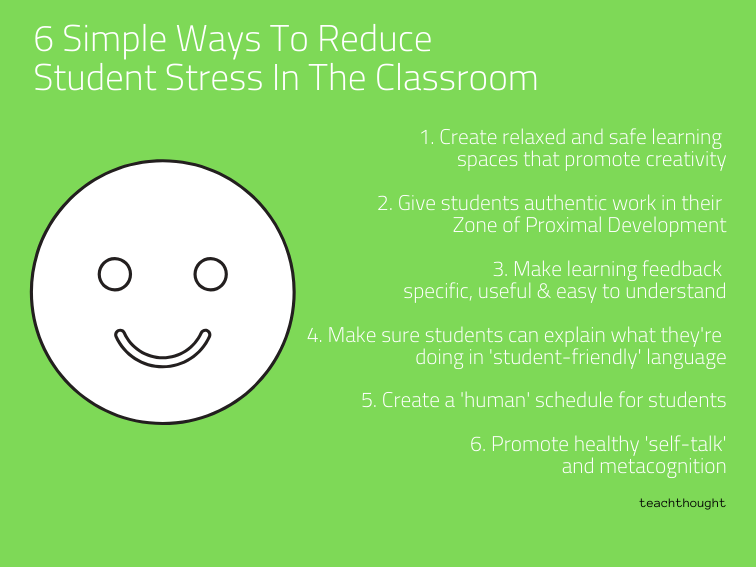
Reduce Student Stress In The Classroom With These 6 Tips
by TeachThought Staff
How do you make your students feel?
Research is starting to show pretty conclusively that the answer to this question can have a profound effect on the learning that occurs within your class or school. More specifically, children who are anxious about their learning, their abilities, their homework–almost anything–will have elevated levels of cortisol, the hormone associated with stress.
Though cortisol has its benefits, a perpetual state of elevated cortisol levels, or even regular spikes in levels are damaging to the body in numerous ways, including impaired cognitive abilities. Studies also show that increased instances of elevated cortisol levels leads to lowered cortisol levels down the road, which is also problematic. The other, more immediate effect is that the physiological energy needed for the body to regulate stress hormone levels detracts from the energy available to focus on learning.
We’ve all seen children in obvious states of emotional distress and it’s well known that students in such a state are incapable of much learning. But students with less visible, perhaps lower levels of stress or anxiety are also affected. The notion of stress in this case is very broad, and many kids, parents (and educators) are unaware of the effects of these stressors. Things like too much video game time, too little breakfast or tension in the home can have profound effects on students’ levels of stress which can mean an imbalance of cortisol.
As educators we need to not only be cognizant of how our behaviour and expectations are affecting our students, increasingly we need to work to counteract the effects of outside stresses which may hinder success in the classroom.
Of course we have no way of discerning the emotional state (and thus the readiness to learn) of each of the students in front of us. But with ever increasing numbers of kids who have difficulty self-regulating most teachers can bet on the fact that some (or many) of the students in front of them on any given day are in either a hyper-aroused or hypo-aroused emotional state.
Here are six simple things that teachers can do to help reduce student stress in the classroom.
6 Simple Ways To Reduce Student Stress In The Classroom
1. Create learning spaces that promote creativity
Avoid clutter, including too much visual stimulation in the form of bright colours and other visual distracters. Yes it’s great to have some decoration, and displaying student work is a must, but avoid having your classroom space look too ‘busy.’ Here are some other ideas for classroom setups that promote creativity and thinking.
Also, as much as possible, allow for movement or ‘fidgeting.’ Sitting still simply isn’t an option for some kids, and for many others it’s doable, but at a high cost in terms of attention and focus. Some teachers have had great success experimenting with exercise balls instead of seats, disc cushions, or even ‘fidget toys.’
Finally, reduce ‘bad’ noise. Maybe try background noise for learning.
Some noise is good, it’s productive and rhythm exercises are great for development. But some kids shut down in the presence of ‘disorganized’ noise. Reduce the number of hard reverberative surfaces where possible, and keep the music area to one corner of the classroom, with a simple divider where possible, so that those not participating can focus on other tasks.
2. Give students work in their Zone of Proximal Development
Work outside of students’ Zone of Proximal Development is either too easy (allowing for distractions and loss of focus) or too difficult (yielding stress).
3. Make learning relevant and feedback specific, useful, and easy to understand
Effective learning feedback is clear, timely, specific, and useful immediately to that student in that circumstance. The wrong feedback can demoralize or confuse students, but the right feedback gives them an obvious place to begin and improve.
4. Have clear learning goals that students can articulate in student-friendly language
If the student can’t explain what they’re doing and why, chances are that they’re at least going to learn less and may not learn at all what you’d hope.
5. Create a schedule that supports students
Most teachers area aware of, and do this, intuitively. But sometimes we try to hurry from one activity to the next. Kids who have difficulty up regulating from a ‘lighter’ activity to something requiring more focus, or down regulating from a busy activity, can get lost in the shuffle if we don’t allow time (and perhaps provide a little guidance).
6. Promote a growth mindset and healthy ‘self-talk’ and metacognition
The right mindset can encourage students to be aware of their own readiness to learn. Young kids will always need some guidance and help to self-regulate, but if students are made aware of how they’re feeling, and if teachers are aware of how they (and their classroom environment) are affecting students, classroom management issues will be reduced and student learning can be improved.
Recent findings in neurophysiology and psychology are emphasizing the importance of self-regulation in children. For a reasonably comprehensive and very practical resource on this topic check out Dr. Stuart Shankar’s “Calm, Alert and Learning.”
Image attribution flickr user flickeringbrad
